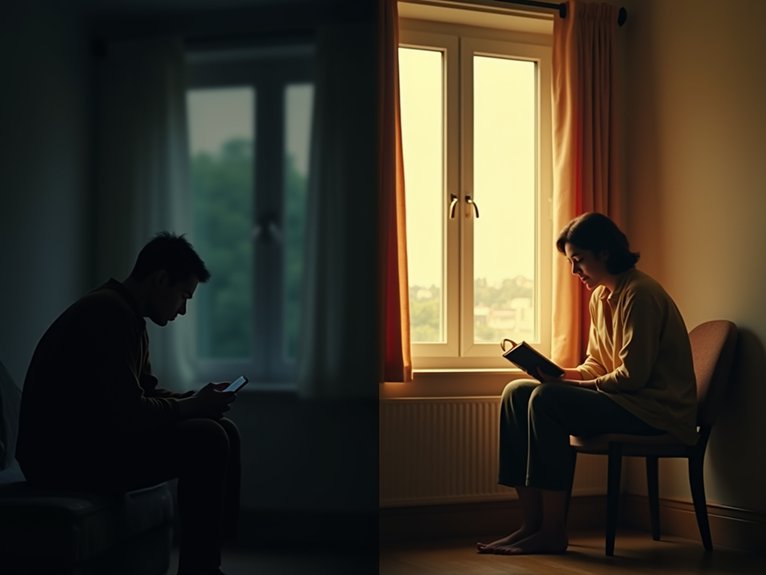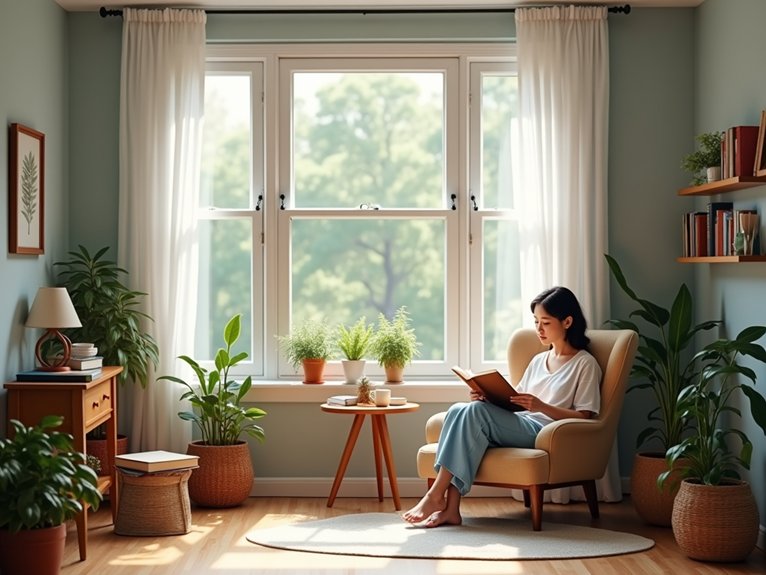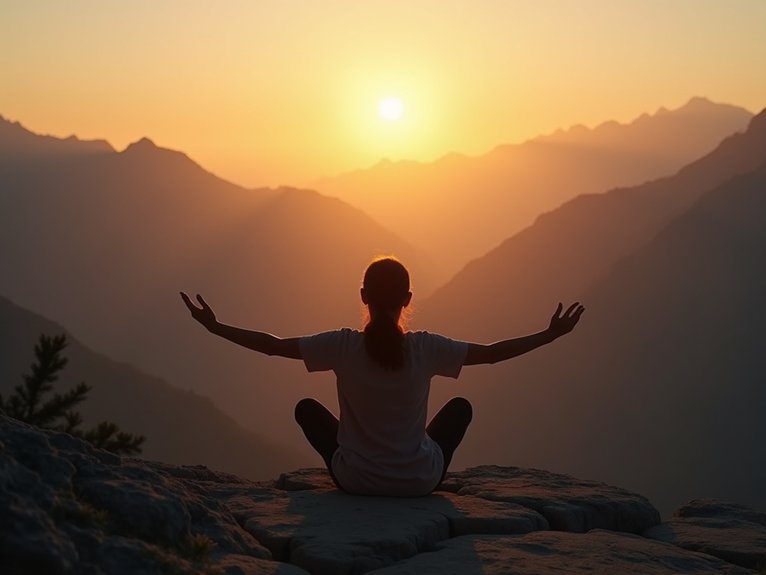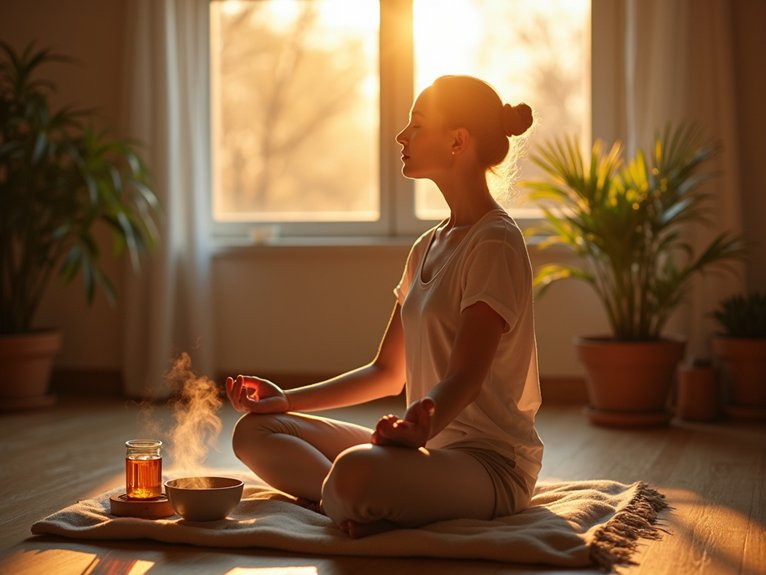Learning to be alone involves distinguishing between loneliness and intentional solitude. Start with brief periods of alone time in a comfortable personal space. Practice mindfulness through meditation, journaling, and gratitude exercises. Engage in solo activities like dining out, hiking, or traveling to build self-reliance. Implement digital detoxes to reconnect with yourself. Embrace creativity during solitary moments and challenge societal pressures to constantly socialize. These strategies transform isolation into meaningful personal growth experiences.
The Difference Between Loneliness and Solitude

Two distinct emotional states often get confused in modern discourse: loneliness and solitude. While both involve being alone, they differ fundamentally in experience and impact.
Loneliness represents an unwanted isolation, characterized by feelings of disconnection, emptiness, and yearning for contact. It typically produces distress and negative health consequences.
Solitude, conversely, is intentional aloneness embraced for personal growth, creativity, or reflection. This state fosters self-awareness, problem-solving, and emotional regulation.
Understanding this distinction helps individuals transform uncomfortable isolation into meaningful solitary experiences—a pivotal skill for psychological well-being in today’s hyper-connected world.
Start Small: Building Your Solitude Muscle
Start Small: Building Your Solitude Muscle
The journey toward comfortable solitude begins with small, manageable steps rather than dramatic lifestyle changes. Individuals can start by scheduling brief periods of intentional alone time—perhaps fifteen minutes of morning reflection or an evening walk without electronic distractions.
As comfort increases, these periods can gradually extend. Activities that engage the mind constructively work well: reading, journaling, or pursuing creative hobbies. Even mundane tasks like cooking or gardening can become meaningful solitary practices.
Many find it helpful to designate a specific space for solitude—a comfortable chair or peaceful corner that signals the mind to embrace peaceful independence rather than dwelling on absence.
Creating a Personal Sanctuary at Home

Creating a Personal Sanctuary at Home
Where one spends solitary time considerably impacts the quality of the experience. Creating a dedicated sanctuary at home provides a foundation for meaningful solitude. This space should reflect personal preferences—whether minimalist or filled with cherished objects.
Key elements include:
- Comfort: Soft textures and proper seating
- Sensory appeal: Pleasant scents, adequate lighting
- Boundaries: Clear signals to others that this is private space
- Personalization: Books, art, or plants that inspire
Even small dwellings can accommodate a sanctuary corner. What matters is intentionality—designing a space that invites introspection rather than escape, cultivation rather than distraction.
Mindfulness Practices for Embracing Alone Time
Meaningful solitude often requires intentional mindfulness practices that ground one in the present moment rather than allowing the mind to spiral into rumination or anxiety.
Simple techniques include focused breathing exercises, where one counts inhales and exhales while noting physical sensations. Body scan meditations systematically bring awareness to each body part, releasing tension.
Journaling provides structure for processing thoughts without judgment. Practicing gratitude during alone time shifts perspective toward abundance rather than lack.
Regular mindfulness practice gradually transforms solitude from something to be feared into a sanctuary for self-discovery and renewal—a valuable skill for those who serve others.
Solo Adventures: Finding Joy in Independent Activities

While mindfulness grounds one in the present moment, actively pursuing solo adventures expands one’s comfort with solitude into new territories. Independent activities build confidence and self-reliance while revealing personal interests often overlooked in social settings.
Effective solo adventures include:
- Solo dining at restaurants with a good book
- Attending films, concerts, or museums alone
- Taking day trips to nearby towns
- Hiking local trails
- Learning a new skill through classes
- Solo travel to destinations of interest
These experiences transform alone time from something merely tolerated into something anticipated. Each adventure strengthens one’s relationship with oneself, creating a foundation of self-sufficiency that enhances all relationships.
Digital Detox: Disconnecting to Reconnect With Yourself
Digital Detox: Disconnecting to Reconnect With Yourself
How often does one pause to ponder the relationship between constant connectivity and inner solitude? The digital world, while connecting people globally, often disconnects individuals from themselves.
A digital detox involves intentionally stepping away from devices to rediscover personal thoughts and feelings. Practitioners recommend starting with small intervals—perhaps an hour daily without phones—then gradually extending this time.
During these periods, individuals can replace screen time with reflective activities: journaling, meditation, or simply observing one’s surroundings. The resulting mental clarity often reveals insights previously obscured by digital noise.
This practice fosters deeper self-awareness and comfort with solitude.
Journaling and Self-Reflection During Solitude
Why does the blank page become such a powerful mirror when one sits alone with their thoughts? The act of journaling transforms internal dialogue into tangible insights. This externalization process helps individuals process emotions and identify patterns in their thinking.
Effective journaling during solitude involves several approaches: stream-of-consciousness writing to release mental clutter, prompted reflection on specific life areas, and gratitude documentation to cultivate positive perspective.
Many find that consistent journaling practice leads to increased self-awareness, reduced anxiety, and clearer decision-making. For beginners, starting with just five minutes daily creates a sustainable foundation for meaningful self-reflection without overwhelming commitment.
Managing Social Pressure and FOMO
Social pressure often manifests as the nagging worry that everyone else is having fun without you. This fear of missing out (FOMO) can undermine one’s ability to enjoy solitude.
Effective strategies to manage these pressures include limiting social media consumption, which often fuels comparison and anxiety. Setting boundaries with friends who may not understand one’s need for alone time is equally important.
Reframing solitude as a conscious choice rather than a social failure helps shift perspective. Remind yourself that meaningful experiences happen in solitude too, and that quality connections matter more than constant social engagement.
Using Alone Time to Discover Your Passions
Solitude often provides the perfect canvas for self-discovery and exploration of personal interests. When individuals intentionally allocate time alone, they create space to experiment with activities that genuinely resonate with them, rather than pursuing socially-influenced hobbies.
This dedicated personal time allows people to follow curiosity without judgment, whether exploring creative pursuits like painting or writing, physical activities such as hiking or yoga, or intellectual endeavors including reading or learning new languages.
Through this exploration, many discover passions they wouldn’t have recognized in social settings. These newfound interests often become sources of fulfillment, self-confidence, and meaningful personal identity beyond social relationships.
Turning Solitude Into a Creative Advantage
Throughout history, the greatest creative minds have harnessed periods of isolation to produce their most influential work. Solitude provides the mental space necessary for deep thinking and creative problem-solving without external interruptions.
To leverage solitude creatively, one should establish a dedicated workspace that inspires productivity. Setting aside specific creative time blocks helps maintain focus and consistency. Keeping a journal nearby captures spontaneous ideas that often emerge during quiet reflection.
Solitude also allows for experimentation without judgment or criticism. This freedom encourages risk-taking and innovative thinking. By embracing alone time as an opportunity rather than a limitation, individuals can develop unique perspectives that contribute meaningfully to their work and communities.



